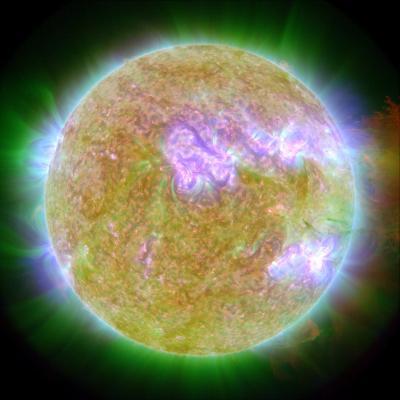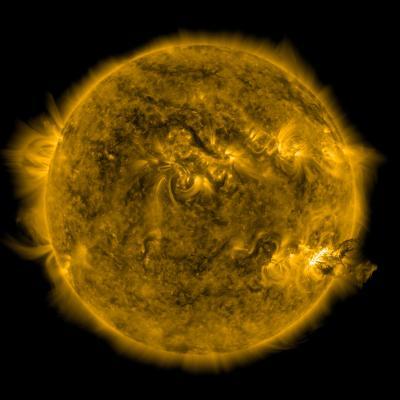Check out this June 7th, 2011 eruption showing dark filaments of gas blasting outward from the Sun's lower right. The solar plasma appears dark against the Sun's bright surface but it actually glows at a temperature of about 18,000 degrees Fahrenheit.
When the blobs of plasma hit the Sun's surface again, they heat up by a factor of 100 to a temperature of almost 2 million degrees F. As a result, those spots brighten in the ultraviolet by a factor of 2 – 5 over just a few minutes.
The tremendous energy release occurs because the in falling blobs are traveling at high speeds, up to 900,000 miles per hour (400 km/sec). Those speeds are similar to the speeds reached by material falling onto young stars as they grow via accretion. Therefore, observations of this solar eruption provide an "up close" view of what happens on distant stars.
This time-lapse movie shows a solar eruption that happened on June 7, 2011. At lower right, material blasts outward from the sun and then splashes down again, creating dramatic flashes of light when infalling blobs hit the solar surface. The images within this movie show light at a wavelength of 171 Angstroms, taken with NASA's Solar Dynamics Observatory. Credit: NASA / SDO / P. Testa (CfA)
"We often study young stars to learn about our Sun when it was an 'infant.' Now we're doing the reverse and studying our Sun to better understand distant stars," notes Testa.
These new observations, combined with computer modeling, have helped resolve a decade-long argument over how to measure the accretion rates of growing stars. Astronomers calculate how fast a young star is gathering material by observing its brightness at various wavelengths of light, and how that brightness changes over time. However, they got higher estimates from optical and ultraviolet light than from X-rays.
The team discovered that the ultraviolet flashes they observed came from the in falling material itself, not the surrounding solar atmosphere. If the same is true for distant, young stars, then by analyzing the ultraviolet light they emit, we can learn about the material they are accreting.
"By seeing the dark spots on the Sun, we can learn about how young stars accrete material and grow." explains Testa.

This photograph shows our sun on June 7, 2011, at the time of an eruption. The source of the eruption glows brightly at lower right. Material blasted outward only to fall back onto the sun's surface. By studying this process, astronomers gained new insights into how young stars grow via stellar accretion. This photo was taken by NASA's Solar Dynamics Observatory. Red shows light at a wavelength of 304 Angstroms, green is 171 Angstroms, and blue is 335 Angstroms. Photo Credit: NASA / SDO / P. Testa (CfA)

This photograph from NASA's Solar Dynamics Observatory catches the beginning of the eruption that took place on June 7, 2011. At lower right, dark filaments of solar plasma arc away from the sun. The plasma lofted off, then rained back down to create "hot spots" that glowed in ultraviolet light. This representative-color image shows light at a wavelength of 171 Angstroms (17.1 nm).Photo Credit: NASA / SDO / P. Testa (CfA)





Comments